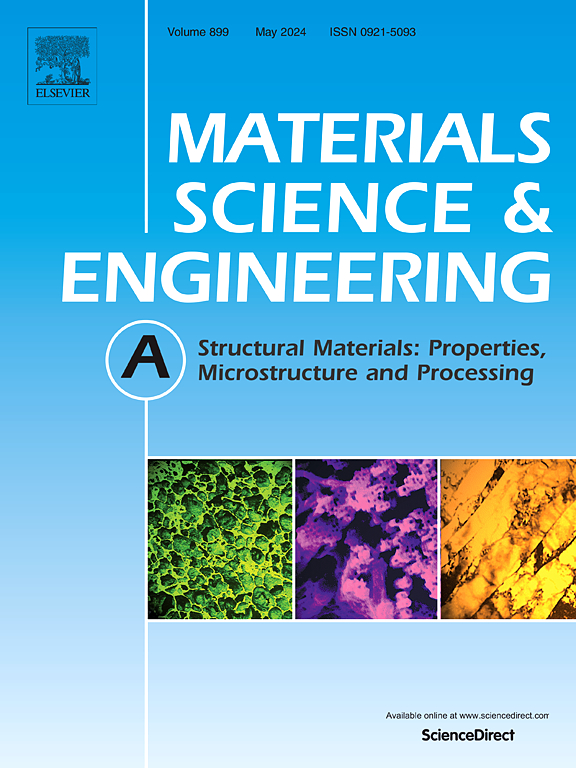引入纯Cu过渡层制备ZK61/7075层状复合材料:挤压温度对组织和力学性能的影响
IF 7
2区 材料科学
Q1 MATERIALS SCIENCE, MULTIDISCIPLINARY
引用次数: 0
摘要
本研究成功地利用挤压技术制备了含纯Cu过渡层的7075/ZK61层压板,克服了7075/ZK61直接堆积挤压的不可成形性问题。系统研究了挤压温度对层压板微观组织和力学性能的影响。结果表明:挤压温度对7075的晶粒尺寸影响不显著,晶粒尺寸以变形晶粒为主;同时,随着挤压温度的升高,基体中析出物增多。而ZK61层则呈现再结晶晶粒,晶粒尺寸随挤压温度的升高而增大。随着挤压温度的升高,ZK61晶粒c轴与挤压方向夹角增大,两层位错密度减小。力学结果表明,随着挤压温度的升高,层压板的强度增大。其中,在450℃的挤压温度下,层压板的最高屈服强度为203 MPa,极限抗拉强度为378 MPa。然而,层压板的延展性与挤压温度成反比,在330℃时的最大伸长率(EL)为19.3%。YS的增加是由于ZK61基底滑移的Schmid因子较低和7075析出相数量增加所致。塑性的降低与ZK61层的晶粒粗化、织构导致基底滑移的SF和几何相容系数的降低以及7075层析出相数量的增加有关。本文章由计算机程序翻译,如有差异,请以英文原文为准。
The preparation of ZK61/7075 laminated composite by introducing pure Cu transition layer: Effect of extrusion temperature on microstructure and mechanical properties
This study successfully prepared 7075/ZK61 laminates containing pure Cu transition layers using extrusion technology, overcoming the non-formability issue of direct 7075/ZK61 stacked extrusion. The influence of extrusion temperature on the microstructure and mechanical properties of laminates was systematically studied. The results indicated that the extrusion temperature had no significant effect on the grain size of 7075, which was mainly composed of deformed grains. Simultaneously, many precipitates were formed in the matrix, and their quantity increased with rising extrusion temperature. In contrast, the ZK61 layer displayed recrystallized grains whose size increased with extrusion temperature. Furthermore, the angle between the grain c-axis of the ZK61 and the extrusion direction increased with rising extrusion temperature, while dislocation density in both layers decreased. Mechanical results showed that the strength of laminates increased with rising extrusion temperature. Specifically, at an extrusion temperature of 450 °C, the laminate exhibited the highest yield strength (YS) of 203 MPa and ultimate tensile strength (UTS) of 378 MPa. However, the ductility of the laminate was inversely proportional to the extrusion temperature, with the maximum elongation (EL) of 19.3 % at 330 °C. The enhanced of YS was attributed to a lower Schmid factor for basal slip in the ZK61 and an increased number of precipitates in the 7075. The decrease in plasticity was related to the grain coarsening in the ZK61 layer, the reduced SF and geometric compatibility factor for basal slip due to texture, and the increased quantity of precipitate phases in the 7075 layer.
求助全文
通过发布文献求助,成功后即可免费获取论文全文。
去求助
来源期刊

Materials Science and Engineering: A
工程技术-材料科学:综合
CiteScore
11.50
自引率
15.60%
发文量
1811
审稿时长
31 days
期刊介绍:
Materials Science and Engineering A provides an international medium for the publication of theoretical and experimental studies related to the load-bearing capacity of materials as influenced by their basic properties, processing history, microstructure and operating environment. Appropriate submissions to Materials Science and Engineering A should include scientific and/or engineering factors which affect the microstructure - strength relationships of materials and report the changes to mechanical behavior.
 求助内容:
求助内容: 应助结果提醒方式:
应助结果提醒方式:


